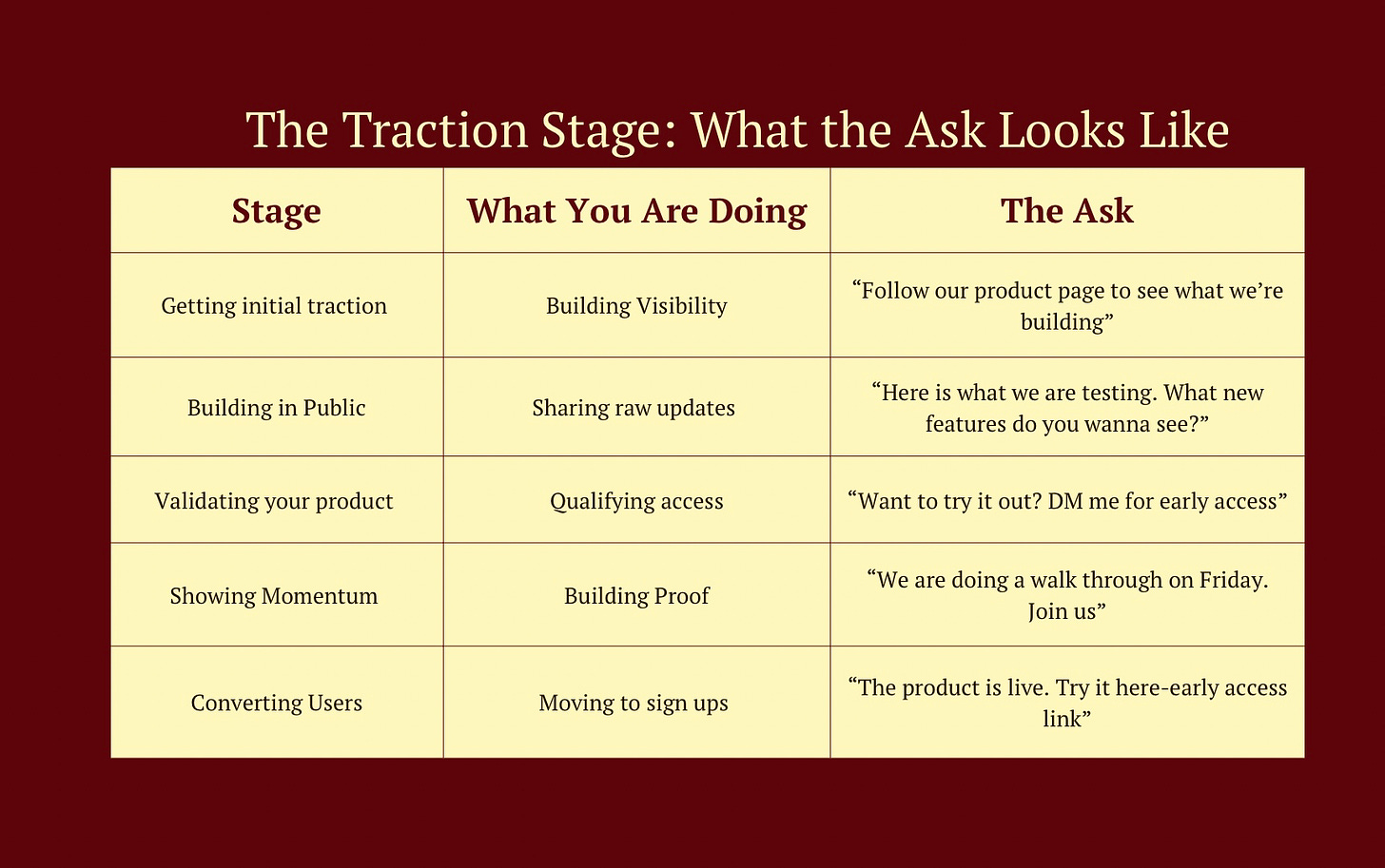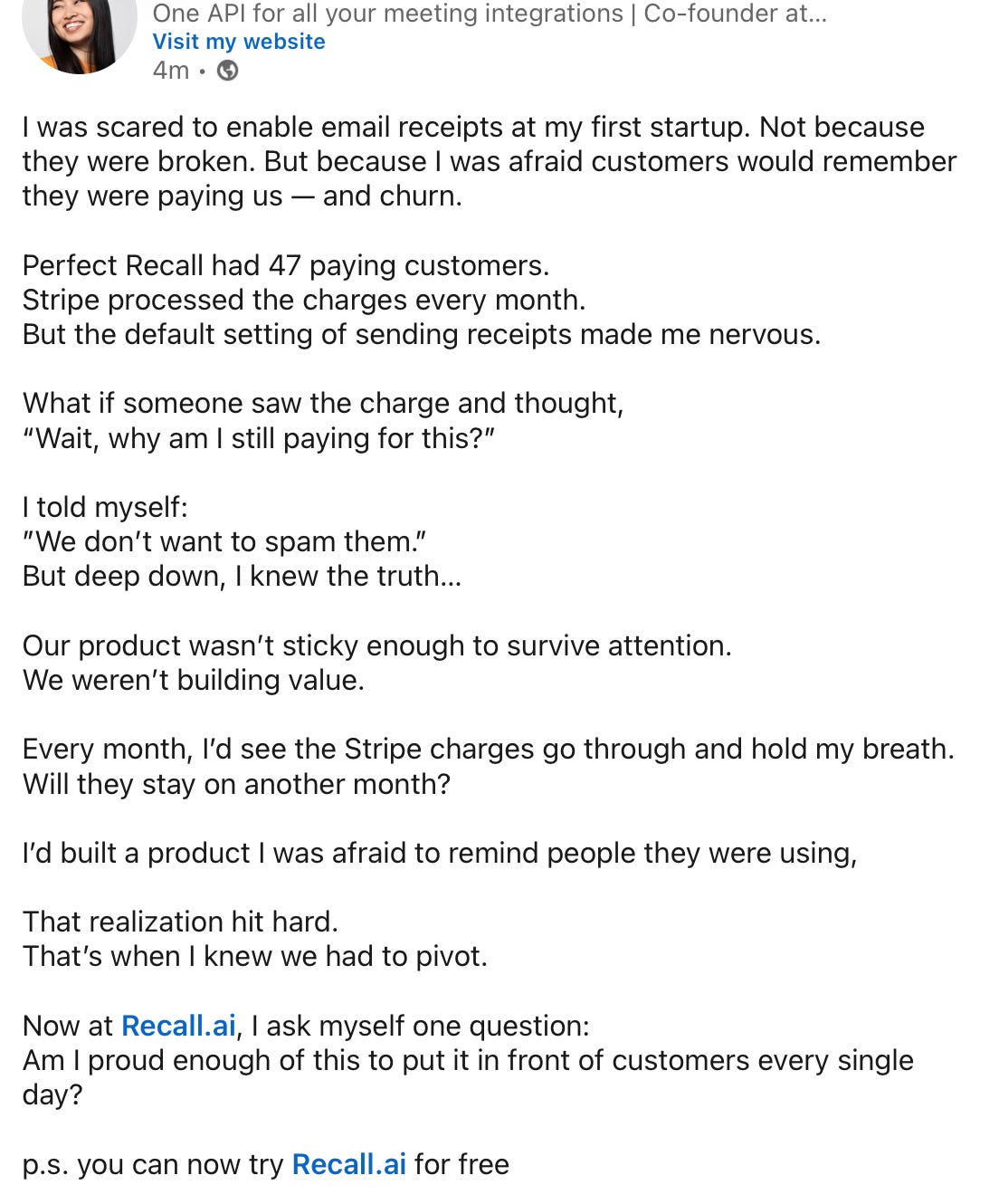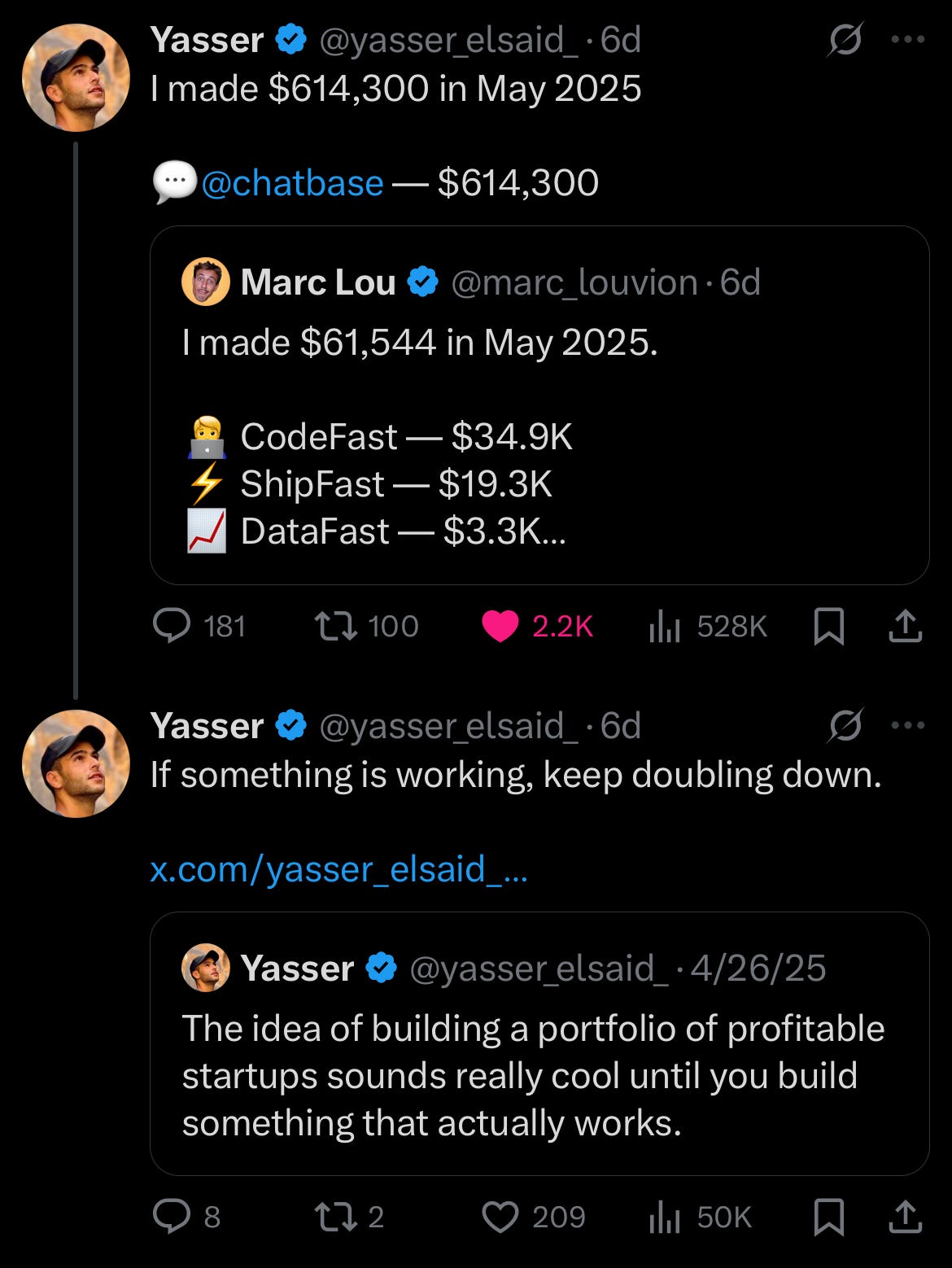How to Structure Your Content to Actually Drive Leads
Your Content Doesn’t Need to Go Viral — It Needs to Convert
Dear Reader,
This is my first post for June.
This month, I’ll continue to break down distribution strategies for startups to go from launch to traction. We're kicking off with one of the most powerful yet underrated distribution channels: founder-led content.
This builds on last month’s newsletter. If you missed it, you can catch up here. It lays the groundwork for what we’re diving into today.
Over the last few weeks, I’ve had multiple founders ask me some version of the same question:
“So if I start posting on LinkedIn, leads will come in, right?”
And here’s the hard truth: No. Posting alone won’t bring in leads.
There’s a difference between just showing up and showing up with content that’s built to get results. And this is what I want to show you today.
Another pushback I hear often is:
“I don’t want to sound like a marketer. I want my posts to feel like me”
Fair. And you should hold on to that.
You can, and should, write content that feels raw, honest, and like you, but that is still able to drive business results because that is the whole point.
However, there is a catch: if you want your content to be effective, you need
Strategy,
Structure, and
Clear intent.
Without these, even the most authentic founder content will fall flat.
Finding that balance is hard most founders struggle with it.
But once you can figure this out, once the leads start coming in while you are asleep, it all starts to make sense.
Who Is This Post For:
Founders: Who want to learn how to create content that attracts the right audience and turns your story into a lead-generation engine.
Marketing or Content Leads: Who want to help their founders create content that builds real momentum and drives meaningful results.
Let’s get into it.
The Content Layering Framework
One of the most important things to understand if you want to create content that converts is a framework I created called The Content Layering Framework.
When you look around you, most of the content you consume is made to educate, entertain, or inform. And there is nothing wrong with this if that is your goal.
Not all content is intended to convert, and not all content can convert.
In fact, by default, most of the content you consume online today is not created with conversion in mind, it’s made to get attention. This is typically fine unless you’re trying to drive traction or run a GTM motion with content at the core.
If you’re not intentionally structuring your content to convert, it won’t.
This is why there’s so much “good” content out there that gets engagement, maybe even praise, but does nothing for the business.
Content Layering changes this.
It’s a strategic way to build content so every single post moves people through a full journey:
Hook → Credibility → Value → Action.
You stack these layers inside every single piece of content so it doesn’t just get read.
It gets remembered, trusted, and acted on.
Now, in marketing, we’re often taught to separate content into funnels:
Top of Funnel = Awareness
Middle of Funnel = Consideration
Bottom of Funnel = Conversion
The key difference with the content layering framework is you do not need to go through a funnel or a 6-week or 6-month-long nurture sequence before you can try to get conversions. You do it with every single post. Basically, you compress the funnel into every single post.
The “Content Layering Framework” exists on the principle that there is no funnel and every single post or content you create can be strategically structured and created to get results.
The 4 Layers of the Content Layering Framework
If you’re running a founder-led content plan to distribute your product, this framework would be extremely relevant for you because it would allow you to create every single post with intention.
Here’s how the “Content Layering Framework” works:
1. The Hook Layer – Make Them Stop
You have 3 seconds to grab someone’s attention. That’s your hook. No matter how good your content is, your reach is limited with a bad hook. A strong hook earns you the right to be read and sets the expectations for what’s to come.
If you need help with your hooks for creating Founder Content, I’ve created a free Hook Vault from analyzing 40+ founder posts, download it for free here.
2. The Credibility Layer – Make Them Trust You
This is where you show you know what you’re talking about fast. You want to pull in your insights, experience, results, or real-world context.
You’re not theorizing, you’ve done it and now you’re speaking from a place of authority. This is important because it fosters confidence that your advice is credible and worth following.
3. The Value Layer – Make Them Learn Something
90% of the time, content that converts helps users reveal or discover something they haven’t thought of before, haven’t been able to articulate, or something they are struggling with and need someone to call out to them so they feel seen.
You need this layer in your content because this is where you deliver value to your audience. This is where you change how they see their problem, offer them solutions, and give them a next step.
Now by this point, if you do it well, you are nearing the close, they trust you, you’ve enlightened them, it’s going to be easier to move to the next stage.
4. The Action Layer – Make Them Act
You’ve grabbed their attention. You’ve earned their trust. You’ve delivered value.
Now, it’s time to guide them exactly where you want them to go. You need to have one clear direction, without confusion.
It’s not:
“Sign up for our product... or drop a comment... or also subscribe.”
You need to pick one action and say it clearly. What do you want them to do?
The reason is that too many options create friction. People start weighing their choices. They scan your post, and when you give them too many options, they default to the easiest one which is to do nothing.
So simplify it. Make the action obvious and easy.
The right people will take action if you show them where to go.
Why Content Layering Matters If You Want Content That Converts
Every single piece of content can be designed to convert.
Instead, we’re told to:
“Nurture first. Educate. Build trust for months. Then maybe… you’ve earned the right to ask for something in return.”
I don’t believe in that, mainly because people don’t consume content in sequences.
Rarely is anyone lurking on your profile consuming your content in chronological order.
They see one really good post that addresses their needs. They decide in seconds.
The average content consumption pattern is closer to:
“Is this relevant to me right now?”
If the answer’s no, they scroll.
So if you’re holding back your ask, waiting for the perfect nurturing sequence to warm them up, you’re wasting time.
I believe in the strategic use of content to:
Deliver value worth acting on
Then ask for the action you want
That doesn’t mean showing up every day like a walking pitch deck.
But it does mean you should design your content with intent.
You can post with an ask every time as long as that ask benefits them too.
I also believe this disconnect exists because people often do not understand conversion.
So, Let’s Reframe “Conversion”
Most people think “conversion” only happens when:
👉 Someone books a call.
👉 Someone pays you.
But in reality, conversion is any action you want your audience to take that they take.
That includes:
Using your product
Subscribing to your newsletter
DMing you to learn more
Commenting with genuine interest
Sharing your content with a cofounder or friend
So here’s the better question to ask before you put out any content:
“What do I want this content to get me today?”
And then create your content to get them to do exactly that.
This is the essence of the Content Layering Framework—structuring every post not just for posting sake but for conversions.
Let me show you an example
Let’s say you’re a founder trying to build traction.
You’ve launched or you’re close and now you need momentum.
Here’s how the “Action Layer” can play out for you across each stage to guide people to take real action:
Now from this example, you will see that each ask is different, but the principle is the same: Every post can be structured to drive an action without ever sounding like a hard sell.
Your content should evolve based on what you need or what stage you are in but it should always be layered to nudge the next step.
Why Most Founder Content Misses This
I have reviewed over 50+ founder content in the past month and these are the most recurring issues I see whenever a founder says: “We’ve been posting… but we’re not seeing results.”:
The posts start with generic hooks or no hooks at all
They show no credibility or any reason why anyone should keep reading or trust their opinion
They move straight to pitching without giving value first
There is no point for people to take the desired action
I Did a Test Run Myself
I wanted to stress-test this framework and share it with you all so I picked the first post that showed up on my own LinkedIn feed and broke it down using the Content Layering framework.
The goal of this post is to get you to attend their live event.
And you can see, that by the time you get to the action layer, you are motivated to take the action.
Adam Robinson, the founder in this post, has built a successful bootstrapped company, purely by running a solid content engine on his LinkedIn using his Founder Brand.
You can optimize for value and conversion at the same time if you’re intentional.
The Art of Turning Your Founder POV into a Business Driver
Stories, no matter how good they are, don’t drive leads unless they’re tied to something that matters to your audience.
Too many founder posts sound like this:
“We launched our MVP last month. It’s been wild.”
Cool… but now what? That post gets likes, and maybe some comments, but doesn’t do much to build traction. It’s a moment, not a magnet.
Here’s how to turn your perspective into content that drives real action:
1. Start With Intent Not Just What’s on Your Mind
Posting something just because it's top of mind is great for engagement, but if you want your content to perform, it needs to have a clear outcome in mind.
Before you post, ask:
What’s the one shift I want my audience to walk away with?
Is this solving a real problem they’re facing right now?
If someone likes this post, is there a natural next step?
Example:
❌ “We launched our MVP last month. It’s been wild.”
✅ “We launched our MVP last month and used one landing page + 2 blog posts to get our first 40 beta users. Here’s how.”
See the difference? The second post is a magnet, the first is just a moment.
2. Anchor Your Story in a Problem You Solved
Telling stories is great but your audience doesn’t just want to hear what happened, they want to know why it matters to them. This means your story has work to do.
It has to:
Surface a real problem
Show what was at stake
Reveal how you solved it
And make it useful for someone else
Here is a really good example:
3. Turn It Into a Playbook So People Remember You
The best founder content does one thing well, it gives your audience something they can implement.
You want them to read your post and think:
“Oh, I’m trying this.”
Or even better:
“This person gets it, I should talk to them.”
The key to doing this is to show people how you got the outcome and make it easy to follow.
You can do that by using:
Playbooks
Frameworks
A before/after breakdown that shows the shift
This teaches them something they can apply immediately.
Look at this example from a post from the founder of Recall Ai, Amanda Zhu. Since Amanda writes about her experience as a founder, this post is extremely relevant to her audience. She gives a replicable framework for how she approaches hiring.
Now, this post also follows the content layering framework—a great hook, credibility, and value — but there is a twist and it’s an open question to you. The action layer here isn’t direct but it’s there.
It’s layered so you instinctively carry out the action they want without even realizing it (Good content marketing btw!) so let’s do a test.
Where is the action layer in this post?
I will wait for the poll results and provide the answers in the next edition of the newsletter.
4. Show, Don’t Just Say (Soft Proof > Hard Sell)
People don’t just want to hear that something worked, they want to see it. You don’t need to brag. You just need to give them context and clues that say:
"This worked. Here’s how we know."
That could look like this:
A screenshot of a user message or Slack thread
Before/after numbers even if it’s small
A one-liner that hints at the win without sounding braggy
Here is an example from the Founder of Chatbase, whose build in public posts has been catalytic to the growth of his bootstrapped startup.
5. Invite the Next Step Without Sounding Salesy
Always end every post with direction. You want to guide your audience to the next step.
The right people will follow it especially if the rest of your content follows the content layering framework.
The Founder Content Blueprint
Here’s a go-to structure I use with clients when we’re building content-led acquisition funnels and it works whether you’re writing a thread, a LinkedIn post, or a full case study:
Hook – To grab attention. Lead with clarity, tension, or a strong POV.
Context – Set the scene. What wasn’t working? What needed to change?
Path – What did you try? What was the thought process? Learnings?
Result – What changed? What outcome did you drive? Show the shift
Lesson – What can others take away or try for themselves?
CTA – Point them toward the next step.
Up Next:
Next week, as part of my ongoing Distribution Done Right series, I’m breaking down Growth Loops and how to use them to distribute your product. If you’re not subscribed yet, now’s the time.
I hope this breakdown shifted how you implement founder content. When structured right, it becomes a lead generation and distribution engine for your brand.
If you’re ready to build a content engine that works like that—post after post with intention, book a strategy call with me here. Let’s build it right.











This is an excellent framework that shows, rather than just telling. I love the examples, really helpful. And I agree with the concept of adding action layers (strategic CTAs) in every post — enough with the sharing value without asking. With plummeting traffic from organic sources (most social networks and Google want to keep users on their platforms), there is a need to double down on CRO strategies like this.